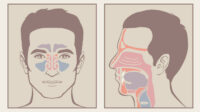The ABOto ENT Written Qualifying Exam the first of two exams you must pass in order to become a Otolaryngologist. This computer-based measures your knowledge in all major areas of Otolaryngology.
How can you best prepare for the ENT boards? One of the most common recommendations is to answer practice questions to uncover trouble areas while you study.
See where you stand for the ENT Written Qualifying Exam by taking these two free otolaryngology questions taken from the BoardVitals ENT Board Review Question Bank.
Question 1
QID: 55746
A 70 year old male presents with a 3 month history of right pulsatile tinnitus with hearing loss, unstable gait, and autophany. ECOG demonstrates a SP/AP ratio of 0.6. A diagnosis of superior semicircular cancal dehiscence is suspected. Which of the following is a good indicator test that would give support to this diagnosis?
A.) Otoacoustic emissions
B.) Tympanometry
C.) Cervical vestibular evoked myogenic potential
D.) Auditory brainstem response
E.) Acoustic reflexes
Answer
C.) Cervical vestibular evoked myogenic potential
Explanation
Correct: (C) Cervical vestibular evoked myogenic potential. Explanation: Superior semicircular canal dehiscence (SSCD) usually demonstrates an elevated SP/AP ration above 0.4 on ECOG. An additonal test that can be a good diagnositic indicator is cervical vestibular evoked myogenic potential (cVEMP). This tests the function of the saccule and the inferior vestibular nerve. In SSCD the threshold of the cVEMP is abnormally low (65 dB or less) making this test a good indicator of SSCD. Choices A,B, D, and E will not specifically differentiate between SSCD and other vestibular disorders. A high SP/AP ratio on ECOG and low threshold on cVEMP is very sensitive for SSCD.
Reference
Cummings Otolaryngology. Chapter 133. Diagnostic Audiology. Saunders Elsevier. 6th Edition. 2015.
Question 2
QID: 48096
Which of the following is a correct indication for surgery in a patient with asymptomatic primary hyperparathyroidism?
A.) Serum calcium greater than 0.5 mg/dL above the upper limit of normal
B.) Creatinine clearance reduced by more than 10% for age in the absence of another cause
C.) Patient is younger than 50 years of age
D.) Measurement of 24-hour urinary calcium is greater than 200 mg/dL
E.) Bone mineral density reduced by more than 1 standard deviation by T-score
Answer
C.) Patient is younger than 50 years of age
Explanation
Correct: C The National Institutes of Health set forth recommendations on management of asymptomatic primary hyperparathyroidism. The indications for surgery are: 1) Serum calcium greater than 1.0 mg/dL above the upper limit of normal 2) Creatinine clearance reduced by more than 30% for age in the absence of another cause 3) Patient is younger than 50 years of age 4) Measurement of 24-hour urinary calcium is greater than 400 mg/dL 5) Bone mineral density reduced by more than 2.5 standard deviations by T-score 6) Patient requests surgery, or patients are unsuitable for long-term surveillance.
Reference
Cummings Otolaryngology. Chapter 124. Management of Parathyroid Disorders. Saunders Elsevier. 6th Edition. 2015.
Ready for more otolaryngology board review questions? The BoardVitals Otolaryngology Question Bank contains more than 1,200 questions targeted to the American Board of Otolaryngology (ABOto) Qualifying Exam for Primary Certification, the OTE (in-training exam), and the American Osteopathic Board of Otolaryngology (AOBOO) Written Qualifying Exam. Sign up for a free trial today!




